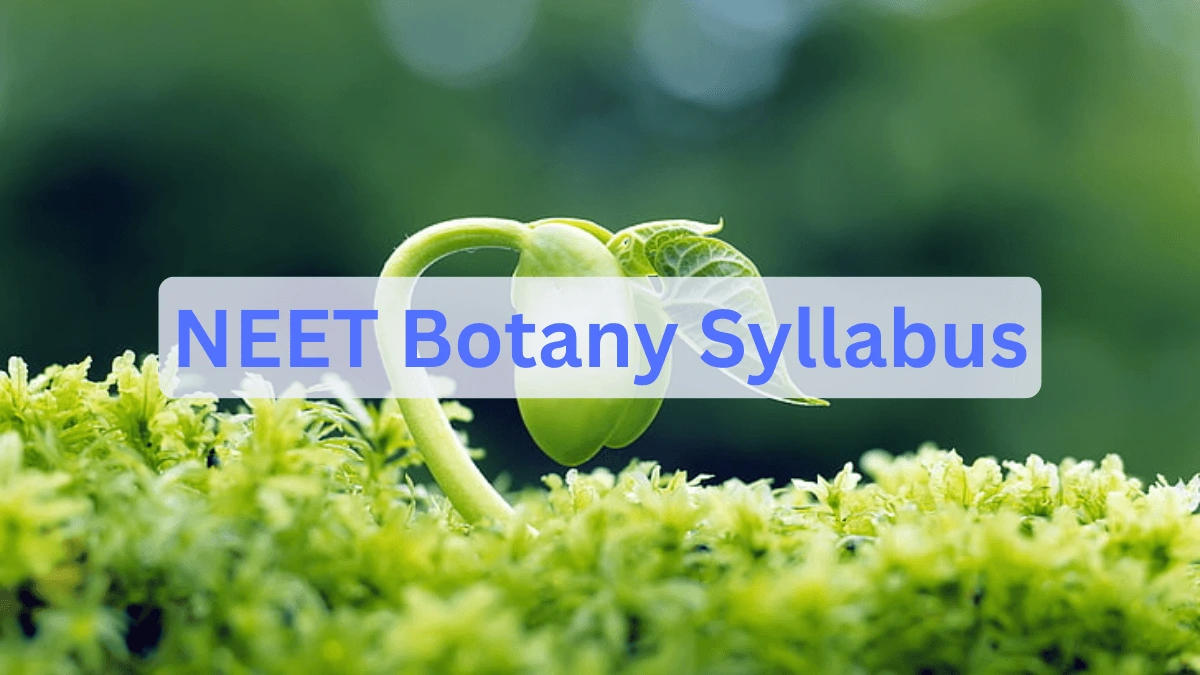Table of Contents
Want to ensure full marks in 25% NEET Syllabus 2025, then you are at the right place as we are providing you with the list of topics and sub-topics that you need to study for the NEET UG 2025 Botany. The NEET Botany syllabus outlines each and every topic that you must go through in context to the NEET UG. The NTA is all set to hold the NEET 2025 exam on May 04, 2025. Candidates can get the detailed NEET UG Biology syllabus 2025 on this page.
NEET Botany Syllabus
The National Testing Agency releases the NEET UG Syllabus in a single PDF file containing the topics for Physics, Chemistry and Biology (Botany + Zoology). While preparing for the exam, candidates divide their study time subject-wise. To give them a better clarity of topics included in various subjects, the NEET subject-wise syllabus for Botany becomes crucial. As per the latest NEET Botany Syllabus, there are 17 chapters included in the exam’s curriculum.
NEET Botany Syllabus 2025
The NEET Botany syllabus consists of topics related to the plant life. As per the NEET UG exam pattern, there are 45 questions from the Botany subject leading to 180 marks. The chapters included in the NEET UG Botany syllabus 2025 has been derived from the standard NCERT text books of class 11th and 12th. Along with the detailed syllabus, students can also obtain the chapter-wise weightage and important topics for NEET 2025.
NEET UG Botany Syllabus 2025
The NEET botany syllabus for 2025 includes a broad range of subjects concerning plant study. It consists of four primary sections: biochemistry, cellular biology, genetics, and ecology. Here are the key chapters highlighted in the botany syllabus for NEET 2025.
| S. No. | Chapters Name |
| 1 | Cell – The Unit of Life |
| 2 | Cell Cycle and Cell Division |
| 3 | The Living World |
| 4 | Biological Classification |
| 5 | Plant Kingdom |
| 6 | Morphology of Flowering Plants |
| 7 | Anatomy of Flowering Plants |
| 8 | Photosynthesis in Higher Plants |
| 9 | Respiration in Plants |
| 10 | Plant Growth and Development |
| 11 | Sexual Reproduction in Flowering Plant |
| 12 | Principle of Inheritance and Variation |
| 13 | Molecular Basis of Inheritance |
| 14 | Microbes in Human Welfare |
| 15 | Organisms and Population |
| 16 | Ecosystem |
| 17 | Biodiversity and Conservation |
NEET Botany Syllabus 2025 in Detail
Candidates aiming for high scores in NEET need to have a comprehensive understanding of the botany NEET syllabus 2025, as it forms a section of the NEET biology syllabus. Keep in mind that the zoology curriculum is included in the NEET biology syllabus and must be studied independently, as it holds similar significance for the test. The detailed syllabus for NEET Botany section for class 11 and class 12 has been shared below.
|
Name of the Unit
|
Topics
|
|
Class 11
|
|
|
The living world
|
What is living?; Biodiversity; Need for classification;: Taxonomy & Systematics; Concept of species and taxonomic hierarchy; Binomial nomenclature
|
|
Biological classification
|
Five kingdom classifications: salient features and classification of Monera: Protista and Fungi into major groups: Lichens; Viruses and Viroids.
|
|
Plant kingdom
|
Salient features and classification of plants into major groups-Algae, Bryophytes, Pteridophytes, Gymnosperms (three to five salient and distinguishing features and at least two examples of each category) Salient features and classification of animals-nonchordate up to phyla level and chordate up to class level (three to five salient features and at least two examples).
|
|
Morphology of flowering plants
|
Morphology and modifications; Tissues; Anatomy and functions of different parts of flowering plants: Root, stem, leaf, inflorescence- cymose and racemose, flower, fruit and seed (To be dealt along with the relevant practical of the Practical Syllabus) Family (malvaceae, Cruciferae, leguminoceae, compositae, gramineae).
|
|
Anatomy of flowering plants
|
Animal tissues; Morphology, anatomy and functions of different systems (digestive, circulatory, respiratory, nervous and reproductive) of an insect (Frog). (Brief account only)
|
|
Cell the unit of life
|
Cell theory and cell as the basic unit of life; Structure of prokaryotic and eukaryotic cell; Plant cell and animal cell; Cell envelope, cell membrane, cell wall; Cell organelles- structure and function; Endomembrane system-endoplasmic reticulum, Golgi bodies, lysosomes, vacuoles; mitochondria, ribosomes, plastids, micro bodies; Cytoskeleton, cilia, flagella, centrioles (ultra structure and function); Nucleus-nuclear membrane, chromatin, nucleolus.
|
|
Cell cycle and cell division
|
Chemical constituents of living cells: Biomolecules-structure and function of proteins, carbohydrates, lipids, nucleic acids; Enzymes-types, properties, enzyme action, classification and nomenclature of enzymes B Cell division: Cell cycle, mitosis, meiosis and their significance.
|
|
Plant Physiology
|
Photosynthesis: Photosynthesis as a means of Autotrophic nutrition; Site of photosynthesis take place; pigments involved in Photosynthesis (Elementary idea); Photochemical and biosynthetic phases of photosynthesis; Cyclic and non cyclic and photophosphorylation; Chemiosmotic hypothesis; Photorespiration C3 and C4 pathways; Factors affecting photosynthesis. Respiration: Exchange gases; Cellular respiration-glycolysis, fermentation (anaerobic), TCA cycle and electron transport system (aerobic); Energy relations- Number of ATP molecules generated; Amphibolic pathways; Respiratory quotient. Plant growth and development: Seed germination; Phases of Plant growth and plant growth rate; Conditions of growth; Differentiation, dedifferentiation and redifferentiation; Sequence of developmental process in a plant cell; Growth regulators- auxin, gibberellin, cytokinin, ethylene, ABA.
|
| Class 12 | |
| Sexual reproduction in flowering plants | Flower structure; Development of male and female gametophytes; Pollination-types, agencies and examples; Outbreeding devices; Pollen-Pistil interaction; Double fertilisation; Post fertilisation events- Development of endosperm and embryo, Development of seed and formation of fruit; Special modes apomixis, parthenocarpy, polyembryony; Significance of seed and fruit formation. |
| Molecular basis of Inheritance | Search for genetic material and DNA as genetic material; Structure of DNA and RNA; DNA packaging; DNA replication; Central dogma; Transcription, genetic code, translation; Gene expression and regulation- Lac Operon; Genome and human genome project; DNA fingerprinting, protein biosynthesis. |
| Principles and process of Biotechnology | Genetic engineering (Recombinant DNA technology) |
| Ecosystem | Patterns, components; productivity and decomposition: Energy flow: Pyramids of number, biomass. energy Biodiversity and its conservation: concept of Biodiversity; patterns of Biodiversity: Importance of Biodiversity; Loss of Biodiversity Biodiversity conservation; Hotspots, endangered organisms. extinction; Red Data Book. biosphere reserves, National parks and sanctuaries, Sacred Groves. |
Students should practice questions from the topics mentioned above from the NEET previous year question papers.
NEET Botany Syllabus 2025 PDF Download
The NEET Botany syllabus is extensive and lengthy, necessitating an effective preparation plan to finish it within the deadline. Candidates should study only those topics which are mentioned in the official syllabus. To help students, we have provided the NEET Botany Syllabus 2025 PDF below for free download.
NEET Botany Important Topics
To give students more insights into the NEET UG Botany syllabus 2025, we are providing them with the important topics for NEET Botany section in the following table.
| Chapter Name | Important Topics |
| Cell – The Unit of Life |
|
| Cell Cycle and Cell Division |
|
| The Living World |
|
| Biological Classification |
|
| Plant Kingdom |
|
| Morphology of Flowering Plants |
|
| Anatomy of Flowering Plants |
|
| Photosynthesis in Higher Plants |
|
| Respiration in Plants |
|
| Plant Growth and Development |
|
| Sexual Reproduction in Flowering Plant |
|
| Principle of Inheritance and Variation |
|
| Molecular Basis of Inheritance |
|
| Microbes in Human Welfare |
|
| Organisms and Population |
|
| Ecosystem |
|
| Biodiversity and Conservation |
|
If you are preparing for NEET 2025 and reviewing the Botany syllabus, it’s crucial to concentrate on essential topics that frequently show up in the exam. By gaining a strong understanding of these subjects, you can enhance your likelihood of achieving better results in the biology portion of the NEET 2025 exam. Candidates should solve the NEET Mock Test to have a crystal clear understanding of these topics.
NEET Botany Chapter-wise Weightage
Prior to beginning their preparation, candidates must get familiar with the chapter-wise weightage of marks for the NEET Botany section in the NEET Syllabus 2025. Comprehending the importance aids in prioritizing subjects that have greater marks. The table outlining the marks allocated to every chapter in the NEET 2025 Botany Syllabus, crucial for efficient study planning.
| Chapters Name | Avg. No. of Questions Asked | Weightage |
| Biodiversity and Conservation | 2 | 4% |
| Anatomy of Flowering Plants | 3 | 7% |
| Cell : The Unit of Life | 2 | 5% |
| Respiration in Plants | 2 | 4% |
| Microbes in Human Welfare | 2 | 4% |
| Cell Cycle and Cell Division | 4 | 9% |
| Molecular Basis of Inheritance | 6 | 14% |
| Principles of Inheritance and Variation | 5 | 10% |
| Sexual Reproduction in Flowering Plants | 3 | 6% |
| Ecosystem | 2 | 4% |
| Morphology of Flowering Plants | 3 | 6% |
| Plant Growth and Development | 3 | 6% |
| The Living World | 0 | 1% |
| Plant Kingdom | 3 | 7% |
| Biological Classification | 1 | 3% |
| Organisms and Populations | 2 | 4% |
| Photosynthesis in Higher Plants | 2 | 4% |
To make sure that you prepare all these topics in a quick time, it is advised to join the best NEET coaching.
Best Books for NEET Botany Syllabus Preparation
Candidates can check the best books to prepare for the NEET UG 2025 Botany syllabus below.
| Book Title | Author/Publication |
| NCERT Biology Class XI and Class XII | NCERT |
| Biology, Vol. 1 and Vol. 2 | Trueman |
| Objective Biology | Dinesh |
| Objective Botany | Ansari |
| Pradeep Guide on Biology | Pradeep Publications |
| Biology Book | GR Bathla Publications |





 NEET City Intimation Slip 2025 Release D...
NEET City Intimation Slip 2025 Release D...
 NTA NEET Cut Off 2025, Expected Cutoff f...
NTA NEET Cut Off 2025, Expected Cutoff f...
 NEET UG 2025: Is NEET Previous years Que...
NEET UG 2025: Is NEET Previous years Que...

